
 The Madagascar Periwinkle (Tsitsirika in our language) is quite a common plant from where I'm from.
The Madagascar Periwinkle (Tsitsirika in our language) is quite a common plant from where I'm from.
It is an evergreen subshrub or herbaceous plant growing to 1 m tall. The leaves are oval to oblong, 2.5–9 cm long and 1–3.5 cm broad, glossy green, hairless, with a pale midrib and a short petiole 1–1.8 cm long; they are arranged in opposite pairs. The flowers are white to dark pink with a darker red centre, with a basal tube 2.5-3 cm long and a corolla 2–5 cm diameter with five petal-like lobes. The fruit is a pair of follicles 2–4 cm long and 3 mm broad.
But what blows my mind is that the drugs vincristine and vinblastine, (which we use as agents for chemotherapy in cancer patients) came from this plant!
Before anything else, thanks to Nedekcir (sent you 100 EC's already), Racquel, and Jacqueline for your valuable inputs! Im giving you 100 EC's. (If you have entrecard, please tell me).
So here's another (also for 100 EC's):
Maybe you can help me.
We bought a lot in Rizal, which is a mountainous area. There is a peculiar tree in our lot that baffles us all, and we are tempted to chop it down for us to plant a new one, but somehow, we sort of allowed it to live...for now. Maybe you can help me identify this tree :

a tree is known for its fruit, and this is the tree's fruit. It's not edible, and its fruit is something i've never seen before. There's a curious orange spider between the third (from left) and fourth fruit that i just noticed on review of this picture.

This is what the tree looks like. It was raining when I took the picture. It's a tall, sturdy tree with greenish, "testicular" fruits that are inedible.


Foliage of our mysterious tree. It's thin slender arms carry parallel leaves.
So please, if you can identify this tree... please help me. thanks!
Please help me identify these plants! I live in the Philippines (Southeast Asia) and found this still unidentified plants in our garden.
Maybe you could help me identify some of them. Leave a comment, get the plant# you want to identify and tell me the name/scientific name. That's just it. i'd be the one to google it up to verify the answer. What's in it for you?
#1 I would be giving out 100 EC's for each plant identified (for those who want it) for entrecard users.Identifying the plant means that I could wikipedia the scientific name of the plant (if you could be specific with the cultivar, the better!) and do some more research about it.
#2 You would be helping this newbie gardener. I'd be forever grateful.
#3 I would visit your blog (and comment) as OFTEN as I can.
I just need your help! Thanks.
Plant # 1:
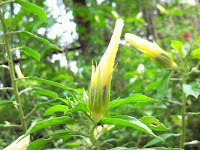


Description : My mom called this flower "morning glory" but in the internet, it's a name for over 1000 species of plants! I think I have two cultivars as shown. It closes up at around 10:00-11:00 AM as shown in the left most picture. I'm looking for the scientific name of this plant.
Plant # 2:

Description: A very nice plant, with bright lavender to violet tube-like flowers. I don't even know if this is a weed or not, but it's not invasive (or so i think it is).
Plant #3 :

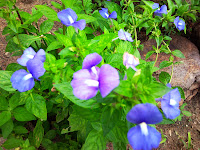
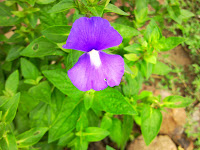
Description : A small plant with a small flower. The flower has two petals, one of which has a white center. It is smaller than the Clitoria and is not a vine.
Plant # 4:

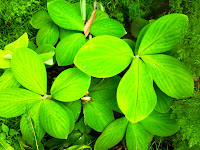
Description : A very beautiful plant with large, velvety leaves. The flower sprouts from a knob-like shaped bud.
Plant # 5:
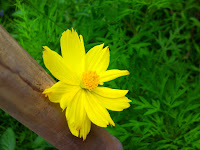


Description : Again, two cultivars of the same flower, which to me appears to be chrysanthemum-like. The leaves are rich green, with grassy texture, which gives me an idea that this might also be a weed.
Plant # 6:
 This is called Vietnam Rose in our country. The flower is indeed rose-like, but it's thornless, and the foliage is slightly different. Looking for : Scientific name.
This is called Vietnam Rose in our country. The flower is indeed rose-like, but it's thornless, and the foliage is slightly different. Looking for : Scientific name.Plant # 7:
 Description : A soft, feathery bushlike plant that has a vivid green color. I just love to touch this plant!
Description : A soft, feathery bushlike plant that has a vivid green color. I just love to touch this plant!There you have it! I hope you could help me. If you want to have higher resolution pictures, you could just click on the picture. Thank you very much and may the good Lord bless your gardens this year!
Out of the many Cassia Fistula seeds (Golden Shower Tree) that I have planted, one has finally germinated!! (Well, actually two have germinated already.)
The seed has a very tough coating. And some literature that I have read on the net would actually have me scarify the seed. The best way to germinate the seeds is to soak them in concentrated sulfuric acid... which is actually hard to get in our humane society. Unless you have contacts with industrial laboratories, you wouldn't get the chemical in our part of the country. So I substituted with another acid... which I wouldn't tell in this post (The secret stays with me... bwahahaha).
The best way to germinate the seeds is to soak them in concentrated sulfuric acid... which is actually hard to get in our humane society. Unless you have contacts with industrial laboratories, you wouldn't get the chemical in our part of the country. So I substituted with another acid... which I wouldn't tell in this post (The secret stays with me... bwahahaha). Next, I submerged the seed into some proteolytic enzyme for about 5 minutes, which was actually not found in literature but the crazy idea just crossed my mind. I would not tell the molecule too. Then I soaked it up in water.
Next, I submerged the seed into some proteolytic enzyme for about 5 minutes, which was actually not found in literature but the crazy idea just crossed my mind. I would not tell the molecule too. Then I soaked it up in water. I also nicked the seeds till some inside part of the seed was seen at the surface. I planted the seeds in soil-less medium using Enrico and prayed to God to make the seeds grow. Since soil-less medium is almost devoid of bacteria (I hope), I was not a bit worried about getting seed infection.
I also nicked the seeds till some inside part of the seed was seen at the surface. I planted the seeds in soil-less medium using Enrico and prayed to God to make the seeds grow. Since soil-less medium is almost devoid of bacteria (I hope), I was not a bit worried about getting seed infection.
When I came home one evening, I saw this baby germinating. I think it's some sort of epigeal germination since the cotyledons sprouted up with the stem.
Well, direct sowing is practiced in my country. But then, it takes a long time for the seed to germinate. I'll update you when I transfer this plant to a pot. I hope this plant grows up to be a tree.
Recently acquired 58 seeds of Cassia Fistula. Read in literature that it would require scarification (acid scarification using sulfuric acid or mechanical scarification using sandpaper). I don't care, i just want these seeds to germinate! I have to have seed dormancy breakthrough! I'm planning to go soil-less with these seeds using Homegrown Seed Starting mix. And I hope I acquire that hard-to-get sulfuric acid in no time.
I'm planning to go soil-less with these seeds using Homegrown Seed Starting mix. And I hope I acquire that hard-to-get sulfuric acid in no time.
I have previously posted that I planted a seed of jackfruit in soil several days ago. This is what it looks now: (Click here to read the previous post)

It has grown to almost 3 inches, and two true leaves are already showing. Some part of the larger leaf are cut though, possibly by ants? (Because I see a lot of them nearby).
I am going to transfer this to a larger pot this week. I hope it recovers well from transplant shock.
I love flame trees!
Here's one I took along the roads of PICC (Philippine International Convention Center) early morning while I was jogging. I actually got some seeds from a young tree (or so I thought), only to find out that it was the dwarf poinciana or Caesalpinia pulcherrima.
I actually got some seeds from a young tree (or so I thought), only to find out that it was the dwarf poinciana or Caesalpinia pulcherrima.
I tried to look for this tree in Manila Seedling Bank, a 4-foot sapling costs about Php 500.00. But i was informed that the roots tend to be invasive and can destroy concrete, so I would have to buy a bigger lot first so I could plant at least one of these.
Here's one taken from my medical school. I get to see this tree almost every day: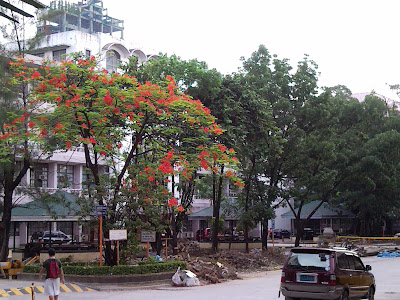 A shanghai beauty shrub grows underneath it. This is a young tree, I suppose.
A shanghai beauty shrub grows underneath it. This is a young tree, I suppose. A close-up picture of the fire flowers. This pictures won't do any justice. You have to see the tree in real life!
A close-up picture of the fire flowers. This pictures won't do any justice. You have to see the tree in real life!
Recently, one of our nephrology doctors gave us a humongous jackfruit, or langka/nangka in Filipino. It certainly smells not good at first, but it tastes great. Does this fruit and durian (Durio sp.) belong to the same family?
Well anyway, on opening the giant fruit, we found seeds that have already started germination (even while it is still inside the fruit!)
I put it in soil, and it has started to come alive!
Once it has come up with true leaves, I will move it to a bigger pot.
The tree of this fruit is beautiful as well, as it would pass for an ornamental tree.
Will blog updates on this tree...
 We acquired a "makopa" plant, or in scientific parlance, Syzygium samarangense. We have this tree in our front gate, the white variety. It's been there for years, and it's now big enough to reach electrical wires. It's still bearing those white fruits that are constantly being picked by birds.
We acquired a "makopa" plant, or in scientific parlance, Syzygium samarangense. We have this tree in our front gate, the white variety. It's been there for years, and it's now big enough to reach electrical wires. It's still bearing those white fruits that are constantly being picked by birds.
This makopa plant was planted on our little Jala-Jala hut. I think it's the dark red variety. It's barely two weeks since it was planted, and we were surprised that it has fruits already! Yep, i thought that this plant should be full grown to bear flowers, but I guess I was wrong.
The fruit became to heave for the plant so the stems were drooping. I placed a bamboo stick to support it. The fruit of course could not be eaten for now. But everyone here's excited on how it would taste.
 This is a picture of a tabebuia tree (sp. heterophylla) or the pink trumpet tree I bought for my mom on mother's day. They have replanted this tree in out nipa hut "resort" house in Jala-Jala. I am excited to see this tree grow and bloom flowers. (However, God causes all things to grow).
This is a picture of a tabebuia tree (sp. heterophylla) or the pink trumpet tree I bought for my mom on mother's day. They have replanted this tree in out nipa hut "resort" house in Jala-Jala. I am excited to see this tree grow and bloom flowers. (However, God causes all things to grow). This is the foliage of the pink trumpet tree.
This is the foliage of the pink trumpet tree.
It's dark green, and shiny. Just beautiful.
I got a group of three leaves for collection. When this tree grows, I would have something that came from the plant when it's still young. This is the foliage of the other tabebuia (chrysotricha) i bought. It's still a plant and probably about 6 months old.
This is the foliage of the other tabebuia (chrysotricha) i bought. It's still a plant and probably about 6 months old.
In my research, I was bothered by the serrations that I contacted the African seller where I got it and told him he must have given me the wrong plant! (There are serrated varieties of Tabebuia, but I particularly wanted the chrysotricha species).
The seller told me that the serrations will disappear as the tree grows and assured me that this is indeed chrysotricha. I give up. If this tree grows up to be a different tree, I just hope it becomes beautiful as well.
I will update you on my tabebuia's progress.
Just realized that the seeds I got where not from Delonix Regia, but actually from Caesalpinia pulcherrima which is the dwarf version of the Fire Tree. Well, if this is not the burning tree, this might be the "burning bush!". hehe
Caesalpinia pulcherrima
From Wikipedia, the free encyclopedia
| Caesalpinia pulcherrima | ||||||||||||||||
|---|---|---|---|---|---|---|---|---|---|---|---|---|---|---|---|---|
Caesalpinia pulcherrima at the Desert Demonstration Garden in Las Vegas | ||||||||||||||||
| Scientific classification | ||||||||||||||||
| ||||||||||||||||
| Binomial name | ||||||||||||||||
| Caesalpinia pulcherrima (L.) Sw. |
In the genus Caesalpinia the most popularly planted species is Caesalpinia pulcherrima. Common names for this species include Poinciana, Peacock Flower, Red Bird of Paradise, Mexican Bird of Paradise, Dwarf Poinciana, Pride of Barbados, and flamboyan-de-jardin. It is a shrub growing to 3 m tall, native to tropical America. The leaves are bipinnate, 20-40 cm long, bearing 3-10 pairs of pinnae, each with 6-10 pairs of leaflets 15-25 mm long and 10-15 mm broad. The flowers are borne in racemes up to 20 cm long, each flower with five yellow, orange or red petals. The fruit is a pod 6-12 cm long.
It is a striking ornamental plant, widely grown in tropical gardens. It is also the national flower of the Caribbean island of Barbados, and is depicted on the Queen's personal Barbadian flag.
In India it is found in the tropical rain forests. With a beautiful inflorescence in yellow, red and orange, it is called "Ratnagundhi" colloquially.
[edit] Medicinal Uses
Medicine men in the Amazon Rainforest have long known some of the medicinal uses for Caesalpinia pulcherrima, which is known as ayoowiri. The juice from the leaves is said to cure fever, the juice from the flower cures sores, and the seeds cure bad cough, breathing difficulty, and chest pain. Four grams from the root is also said to induce abortion in the first trimester of pregnancy.[1]
What if we could just geotag all the rare trees in the Philippines so that enthusiasts would not go into much trouble finding it?
Just thinking...
Got seeds of poinciana as well!
Delonix regia
From Wikipedia, the free encyclopedia
| Delonix regia | ||||||||||||||||||
|---|---|---|---|---|---|---|---|---|---|---|---|---|---|---|---|---|---|---|
 Tree in full bloom in the Florida Keys | ||||||||||||||||||
| Conservation status | ||||||||||||||||||
| Scientific classification | ||||||||||||||||||
| ||||||||||||||||||
| Binomial name | ||||||||||||||||||
| Delonix regia (Boj. ex Hook.) Raf. |
Delonix regia is a species of flowering plant from the Fabaceae family, noted for its fern-like leaves and flamboyant display of flowers. Often grown as an ornamental tree and given the name Royal Poinciana or Flamboyant, it is also known as Krishnachura, Gulmohar, Peacock Flower, Flame of the Forest, Malinche, and Tabachine[1], and one of several named the Flame tree. The species was previously placed in a genus Poinciana, named for Phillippe de Longvilliers de Poincy who is credited with introducing the plant to the Americas.
The tree's vivid red/vermilion/orange/yellow flowers and bright green foliage make it an exceptionally striking sight.
The Royal Poinciana is endemic to Madagascar, where it is found in the Madagascar dry deciduous forests. In the wild it is endangered, but it is widely cultivated elsewhere. In addition to its ornamental value, it is also a useful shade tree in tropical conditions, because it usually grows to a modest height (typically around 5 m, though it can reach as high as 12 m) but spreads widely, and its dense foliage provides full shade. In areas with a marked dry season, it sheds its leaves during the drought, but in other areas it is virtually evergreen.
The flowers are large, with four spreading scarlet or orange-red petals up to 8 cm long, and a fifth upright petal called the standard, which is slightly larger and spotted with yellow and white. The naturally occurring variety flavida has yellow flowers. Seed pods are dark brown and can be up to 60 cm long and 5 cm wide; the individual seeds, however, are small, weighing around 0.4 g on average. The compound leaves have a feathery appearance and are a characteristic light, bright green. They are doubly pinnate: Each leaf is 30-50 cm long and has 20 to 40 pairs of primary leaflets or pinnae on it, and each of these is further divided into 10-20 pairs of secondary leaflets or pinnules.
The Royal Poinciana requires a tropical or near-tropical climate, but can tolerate drought and salty conditions. It is very widely grown in the Caribbean, Hong Kong, the Canary Islands, Taiwan and southern China, and is also the city tree of Tainan, Taiwan and Xiamen, Fujian Province, People's Republic of China. National Cheng Kung University, a university located in Tainan, put Royal Poinciana on its emblem. It also grows throughout southern Brazil, with ornamental trees in Rio Grande de Sul (Canoas and Porto Alegre) http://www.thewoodexplorer.com/maindata/we1388.html#Regions_of_Distribution
In the United States, it grows only in South Florida, Southwest Florida, the Rio Grande Valley of South Texas, ranging from the low deserts of Southern Arizona (to as high as Tucson), Southern California, Hawaii, Puerto Rico, U.S. Virgin Islands, Guam and the Commonwealth of the Northern Mariana Islands, where it is the official tree of the islands. It is much adored in the Caribbean; for example, many Puerto Rican paintings feature Flamboyant Trees. The Poinciana is also the national flower of St. Kitts and Nevis.
The Royal Poinciana is regarded as naturalised in many of the locations where it is grown, and is seen by some as an invasive species in some parts of Australia, partly because its dense shade and root system prevent the growth of other species under it. It is also found in India, where it is referred to as the Gulmohar, or Gul Mohr[2]. In West Bengal (India) and Bangladesh it is called Krishnachura.
The seed pods of the Royal Poincianas are used in the Caribbean as a percussion instrument known as the shak-shak or maraca.
Contents[hide] |
[edit] Flowering season
- South Florida: June
- Caribbean: May–September
- India: April–June
- Australia: December–February
- Northern Mariana Islands: March-June
- United Arab Emirates: April-June
- Philippines: September
Recently acquired 156 seeds of Cassia fistula (for free!!).
I'm still studying what to do with them and how would I successfully germinate each one of them. I am currently aware that you have to sow seeds in concentrated sulfuric acid for it to successfully germinate.
Learned that it's the national tree of Thailand, though.
Here's another tree I acquired from Mr. Roos :
Description
This little tree impressed me the first time I encountered it on a stroll through Orlando's Leu Gardens. Although not in bloom at the time, it's silvery gray bark, attractive foliage and pleasing form caused me to take notice. But I wasn't charmed enough to stomp through a flower bed to take a look at it's identification tag so this tree remained a stranger to me. That is until one March when I rounded a corner and was startled by the sight of my stranger transformed into an explosion of pink perfectly presented against a cobalt blue spring sky. I (carefully) dashed through the bed, grabbed the ID tag and made the acquaintance of the fabulous pink trumpet tree, Tabebuia heterophylla!
One of several Tabebuias grown in Florida, pink trumpet is a semi-deciduous tropical tree that grows to an ultimate height of 50 ft (15.2 m). It tends to assume a narrow pyramid or dome shape. The 3 in (7.6 cm) trumpet flowers are borne in clusters held at the ends of branches. Very ornamental palmate compound leaves are composed of unequally sized leaflets that emerge after the tree flowers.
Location
The botanical reference Hortus Third indicates that there are over 100 species in the genus Tabebuia, all of which are native to the American tropics. Pink trumpet tree is native to the islands of the West Indies. It and related species, such as the silver trumpet tree, are very popular landscape plants in south Florida and other frostfree, humid climates.
Culture
Will grow in many types of soil, from wet to dry, as long as it is well drained. Fertilize twice a year in spring and summer..
Light: Full sun.
Moisture: Provide good drainage. Will tolerate short periods of drought once established.
Hardiness: USDA Zones 10 - 11. This is a tropical tree that is damaged by frost. The tree in the photograph is growing in Central Florida (Zone 9) where it has become a popular landscape item. By planting the tree in a protected location (live oaks shield northern exposure) the range of this beauty can be extended.
Propagation: Propagated by seeds obtained from the large 12 in (30.5 cm) pods. Selected varieties are available that are grafted on to seedling stock.
 |
| The pink trumpets are arranged in dense flower clusters on leafless branches. |
A perfect tree for small yards and patio areas that will not grow out of scale. Use in informal plantings mixed with evergreens or as lawn highlight (same color as pink plastic flamingos but even more tropical!) Pink tab is perfect for street planting and traffic islands where its durability is appreciated by maintenance workers and it's beauty provides interest and diversion to stressed-out South Florida motorists as they're stuck in gridlock.
Features
Spectacularly flamboyant when in bloom, pink trumpet tree is an otherwise understated beauty that requires little maintenance and is not bothered by pests.
Taken from Floridata.










